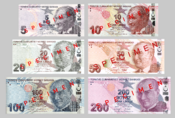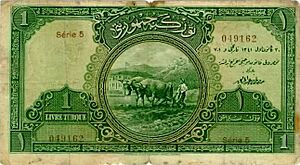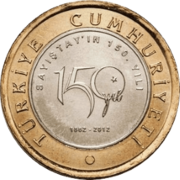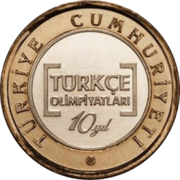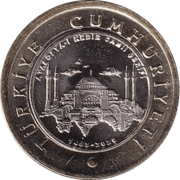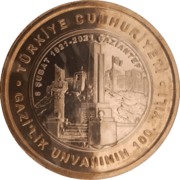Turkish lira facts for kids
Quick facts for kids Turkish lira |
|||||
|---|---|---|---|---|---|
|
|||||
| ISO 4217 Code | TRY | ||||
| User(s) | |||||
| Inflation | 75.50% | ||||
| Source | YCharts [1]. | ||||
| Method | CPI | ||||
| Subunit | |||||
| 1⁄100 | Kuruş | ||||
| Symbol | ₺ | ||||
| Kuruş | kr | ||||
| Plural | liralar | ||||
| Coins | |||||
| Freq. used | 50kr, ₺1 | ||||
| Rarely used | 1kr, 5kr, 10kr, 25kr, ₺5 | ||||
| Banknotes | |||||
| Freq. used | ₺5, ₺10, ₺20, ₺50, ₺100, ₺200 | ||||
| Printer | CBRT Banknote Printer | ||||
| The plural is rarely used (mostly as an indefinite noun) and it is never used when referring to amounts, e.g. üç lira (three lira), bin lira (one thousand lira). | |||||
The lira (Turkish: Türk lirası) is the official money of Turkey and Northern Cyprus. It is also used in parts of northern Syria. The lira has a special sign: ₺. Its international code is TRY, and it's often shortened to TL. One lira is made up of one hundred kuruş.
Contents
History of the Turkish Lira
The Ottoman Lira (1844–1923)
The idea of the lira comes from an old Roman weight unit called the libra. This unit was used for silver. The name "lira" spread across Europe and the Middle East. Many modern currencies, like the former Italian lira and the British pound, come from this ancient idea.
The lira became the main money in Turkey in 1844. Before that, the kuruş was the main unit. After 1844, the kuruş became a smaller part of the lira, with 100 kuruş making up one lira. The Ottoman lira was used until the end of 1927.
The First Turkish Lira (1923–2005)
The first banknotes of the new Turkish Republic showed Mustafa Kemal Atatürk, who was the founder of modern Turkey. This started in 1926. After Atatürk passed away, his picture was replaced by İsmet İnönü on some banknotes. But later, Atatürk's portrait returned and has been on all banknotes since.
Over time, the value of the Turkish lira changed a lot compared to other currencies like the US dollar. For example:
- In 1960, US$1 was worth TL 9.
- By 1980, US$1 was worth TL 80.
- By 2000, US$1 was worth TL 620,000.
- By 2005, US$1 was worth TL 1,350,000.
Because its value dropped so much, the Guinness Book of Records called the Turkish lira the world's least valuable currency for several years.
The Second Turkish Lira (2005–Present)
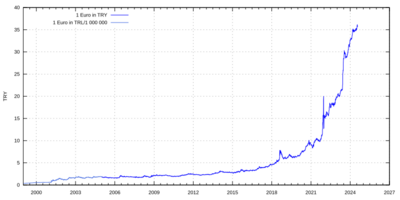
To fix the problem of the lira having too many zeros, Turkey made a big change on January 1, 2005. They removed six zeros from the currency! This meant that 1 new Turkish lira (YTL) was equal to 1,000,000 old Turkish liras (TRL). This was called a "redenomination."
For a few years, the new currency was called Yeni Türk lirası, meaning "New Turkish lira." The letter "Y" in its abbreviation (YTL) came from the Turkish word for "new." But starting in January 2009, the "new" part was removed. Now, it's just called the "Turkish lira" again, and its abbreviation is "TL."
All current Turkish banknotes and most coins feature portraits of Mustafa Kemal Atatürk.
Recent Economic Challenges (2018–Present)
Since 2018, the Turkish lira has faced some tough times. Its value has gone down quickly compared to currencies like the US dollar and the euro. This means you need more liras to buy the same amount of dollars or euros.
Many experts believe this is due to high inflation (when prices go up and money buys less) and decisions about interest rates. Despite these challenges, the Turkish government has tried different ways to help the economy. The value of the lira has continued to change, reaching new lows at times. For example, in late 2021, the lira lost half of its value compared to the start of that year.
Turkish Coins
Since January 1, 2009, new coins have been used. They no longer have the word "yeni" (new) on them. These coins come in different values: 1 kuruş, 5 kuruş, 10 kuruş, 25 kuruş, 50 kuruş, and ₺1. The 50 kuruş and ₺1 coins also had their metal parts swapped around.
| Current Turkish lira coins [2] | |||||||||||||
|---|---|---|---|---|---|---|---|---|---|---|---|---|---|
| Image | Value (kuruş) |
Technical parameters | Description | Date of | |||||||||
| Obverse | Reverse | Diameter (mm) |
Thickness (mm) |
Mass (g) |
Composition | Edge | Obverse | Reverse | first minting | issue | |||
| 1kr. | 16.5 | 1.35 | 2.2 | 70% Cu, 30% Zn | Plain | Value, Crescent-star, year of minting | Snowdrop | "TÜRKİYE CUMHURİYETİ", Mustafa Kemal Atatürk |
2008 | 1 January 2009 | |||
| 5kr. | 17.5 | 1.65 | 2.9 | 65% Cu, 18% Ni, 17% Zn | Tree of life | ||||||||
| 10kr. | 18.5 | 3.15 | Rumi motif | ||||||||||
 |
 |
25kr. | 20.5 | 4 | Reeded | Kufic calligraphic | |||||||
 |
 |
50kr. | 23.85 | 1.9 | 6.8 | Ring: 65% Cu, 18% Ni, 17% Zn Center: 79% Cu, 17% Zn, 4% Ni |
Large reeded | Bosphorus Bridge and Istanbul silhouette | |||||
 |
 |
₺1 | 26.15 | 8.2 | Ring: 79% Cu, 17% Zn, 4% Ni Center: 65% Cu, 18% Ni, 17% Zn |
inscribed, T.C. letters and tulip figure | Rumi motif | ||||||
 |
 |
₺5 (Commemorative) | 28.15 | 8.25 | Ring: 64% Cu, 32% Zn, 4% Ni Center: 64% Cu, 27% Ni, 9% Zn |
Large reeded | Rub el Hizb | 2023 | 29 October 2023 | ||||
| These images are to scale at 2.5 pixels per millimetre. For table standards, see the coin specification table. | |||||||||||||
Special Commemorative Coins
Since 2012, Turkey has made special ₺1 coins to celebrate important events or anniversaries. These are called "commemorative coins" and are used just like regular coins.
-
Commemorative coin for martyrs and veterans of July 15th (2016)
-
Commemoration of Hagia Sophia's reversion to mosque (2020)
-
100th year of honoring Antep province with the ghazi title (2021)
Other special coins include:
- 2018: For the inauguration of the President Recep Tayyip Erdoğan.
- 2020: For the 100th anniversary of the Grand National Assembly of Turkey.
- 2022: For the opening of the 1915 Çanakkale Bridge.
- 2022: For the 100th anniversary of the Great Offensive.
- 2023: A ₺5 coin for the 100th year of the Republic.
Turkish Banknotes
A new set of banknotes, called the "E-9 Emission Group," started being used on January 1, 2009. These new banknotes are called "Turkish lira" instead of "new Turkish lira." They also include a new ₺200 banknote. The banknotes are different sizes to make it harder to copy them.
A cool thing about this new series is that each banknote features a famous Turkish person, rather than just places or buildings. For example, the ₺5 banknote is mostly purple and shows Aydın Sayılı, a famous scientist.
| Current Turkish lira banknotes 9. Emission Group | ||||||||||||
|---|---|---|---|---|---|---|---|---|---|---|---|---|
| Image | Value (₺) |
Dimensions (mm) |
Main Colour | Description | Date of issue | |||||||
| Obverse | Reverse | Obverse | Reverse | Watermark | ||||||||
| ₺5 | 130 × 64 | Brown | Mustafa Kemal Atatürk | Aydın Sayılı: solar system, atom, left-handed Z-DNA helix. |
Mustafa Kemal Atatürk, value | 1 January 2009 | ||||||
| Purple | 8 April 2013 | |||||||||||
| ₺10 | 136 × 64 | Red | Cahit Arf: Arf invariant, arithmetic series, abacus, binary sequence |
1 January 2009 | ||||||||
| ₺20 | 142 × 68 | Green | Mimar Kemaleddin: Gazi University main building, aqueduct, circular motif and cube-globe-cylinder symbolizing architecture |
|||||||||
| ₺50 | 148 × 68 | Orange | Fatma Aliye Topuz: flower and literary figures |
|||||||||
 |
 |
₺100 | 154 × 72 | Blue | Buhurizade Itri: musical notes, instruments and Mevlevi figure |
|||||||
 |
 |
₺200 | 160 × 72 | Pink | Yunus Emre: Yunus's mausoleum, rose, pigeon and the line "Sevelim, sevilelim" (Let us love, let us be loved) |
|||||||
| These images are to scale at 0.7 pixel per millimetre. For table standards, see the banknote specification table. | ||||||||||||
The Turkish Lira Sign
The Turkish lira used to be shown as TL. This was the opposite of the old Ottoman lira sign, which was LT.
In 2012, the Central Bank of the Republic of Turkey created a brand new symbol for the Turkish lira. This new sign was chosen after a country-wide competition. The winning design, made by Tülay Lale, looks like the letter L shaped like half an anchor, with a double-striped letter T inside it.
When the new symbol was shown to the public, the Prime Minister at the time, Recep Tayyip Erdoğan, explained its meaning. He said the anchor shape shows that the currency is a "safe harbor." The lines pointing upwards represent its growing importance and value.
The new Turkish lira sign was added to computer systems in September 2012. On computers using Turkish keyboards, you can type it by pressing the AltGr and T keys together.
Current Exchange Rates
| Current TRY exchange rates | |
|---|---|
| From Google Finance: | AUD CAD CHF EUR GBP HKD JPY USD AZN NZD RUB |
| From Yahoo! Finance: | AUD CAD CHF EUR GBP HKD JPY USD AZN NZD RUB |
| From XE.com: | AUD CAD CHF EUR GBP HKD JPY USD AZN NZD RUB |
| From OANDA: | AUD CAD CHF EUR GBP HKD JPY USD AZN NZD RUB |
| From fxtop.com: | AUD CAD CHF EUR GBP HKD JPY USD AZN NZD RUB |
See also
 In Spanish: Lira turca para niños
In Spanish: Lira turca para niños
- Banknotes of Turkey
- Coins of Turkey
- Economy of Turkey
- Economy of Northern Cyprus
- Ottoman lira


